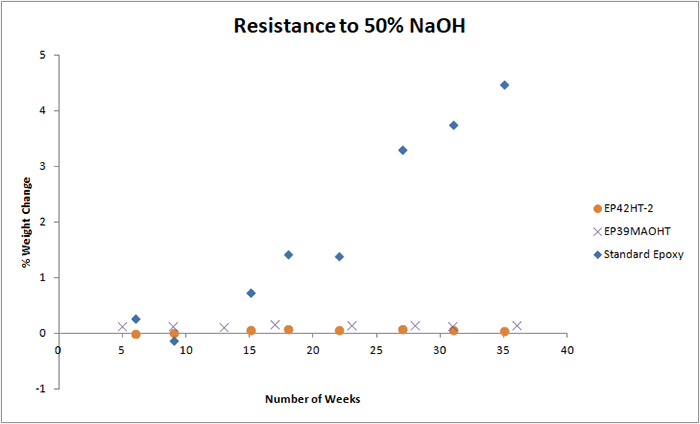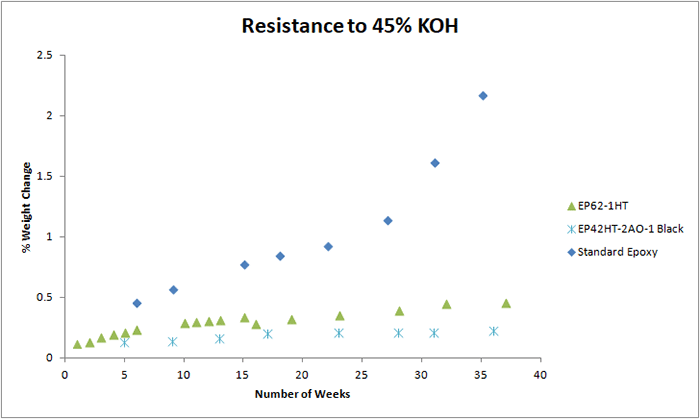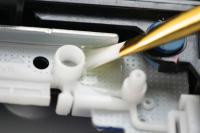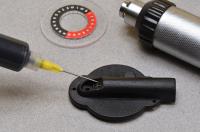Many Master Bond epoxy systems are formulated with superior chemical resistance. In the lab we continually test our materials by exposing them to specific chemicals over a long period of time. A common way of testing chemical resistance of an epoxy is immersing a sample in a chemical and measuring its change in weight over time. A significant loss or gain in weight would indicate a decreased ability of a material to stand up to chemical exposure. These tests allow us to more accurately recommend the right adhesive based on specific application requirements.
Here we are focused on testing our epoxies for their resistance to bases. The compounds we used for testing are two component epoxy systems with good overall chemical resistance: EP62-1HT, EP42HT-2, EP39MAOHT, and EP42HT-2AO-1 Black. A few thin castings, roughly 2 inches in diameter and around 0.125 inches thick, were made for each product and cured in accordance to their specifications. Once the cured samples were created and initial weight was recorded, we submerged them in the most common base solutions, 50% Sodium hydroxide (NaOH) and 45% Potassium hydroxide (KOH). Then we continued recording weekly weight measurements. Although we plan to carry on with these weekly weight recordings over a longer period of time, below you will see the results from the first 37 weeks of testing, demonstrating the percentage of weight change over time.


To put these numbers into comparison, a casting of a standard epoxy that hasn’t been formulated for chemical resistance was also tested under these same conditions. As you can see in the graphs, the standard epoxy was not as resistant to the bases as the other epoxies tested, considering that it demonstrated a significantly higher weight gain over time. In general, a swelling of less than 1% can be considered excellent, especially since this test may be more rigorous compared to actual service conditions. It is also worth noting that in the context of a bonded joint or a potted assembly the exposure to bases might not be as severe or direct, as in the above test conditions.
Please note, when choosing an epoxy for an application where the resistance to bases is critical, many other factors must be considered in addition to the chemical resistance. Each of the epoxies in the chart above offers a distinct set of performance properties. For example, if thermal conductivity is needed, EP39MAOHT or EP42HT-2AO-1 Black would be good options.
Master Bond Popular Products
 |
EP62-1HT Superior resistance to harsh chemicals, particularly to acids. Two part epoxy has long pot life at ambient temperatures. High bond strength properties. Ideal for bonding and coating. Good flow. Reliable electrical insulator. Serviceable from -60°F to +450°F. Tg 150-160°C. Shore D hardness 80-90. |
 |
EP42HT-2 Bonding, sealing, coating, potting compound. Heat, chemical, steam resistant. Superior optical transmission properties. Solvent free. Withstands exposure to acids, alkalis and many solvents. Castable up to 2-3 inches. Cures readily at ambient temperature. Service temperature range -60°F to +450°F. |
 |
EP39MAOHT Thermally conductive, low viscosity potting/encapsulation compound. Superior dielectric properties. Versatile cure schedules. Convenient one to one mix ratio weight or volume. Minimal shrinkage and stress development. Resists thermal cycling and mechanical shocks. Service temperature range -100°F to +400°F. |
 |
EP42HT-2AO-1 Black Good heat conduction. Serviceable from 4K to +400°F. Resists water, oils, fuels. Excellent dielectric properties. Enhanced dimensional stability. Castable up to 2-3 inches thick. Low shrinkage upon cure. Good flow. Meets NASA low outgassing standards. |
